1.2 Energy Issues: A Brief Explanation
Due to the large amount of media attention on energy issues, it is a familiar fact that world energy consumption is growing every day (Figure 1.2.1). If this trend does not change, global energy consumption will increase by 53% from 2008 to 2035 (IEO, 2011). However, large differences exist between countries; for instance, in Western countries (OECD countries), energy consumption will grow moderately by about 20%. On the other hand, in emerging economies (non-OECD countries), energy consumption will dramatically grow more than 80% over the next 25 years. A rising trend has also been observed for global household electricity consumption, which increased 3.4% per annum on average from 1990 to 2006, approximately 2% per year in Europe and 6% per year in non-OECD countries (OECD/IEA, 2009).
Figure 1.2.1 Global energy consumption in the period 1990–2035 (IEO, 2011)
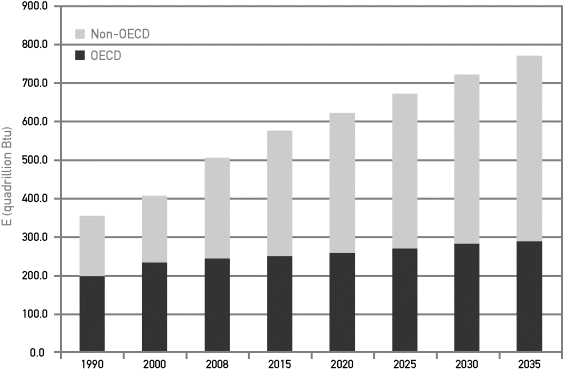
Currently the most commonly used fuels are fossil fuels: oil, coal, and gas. A relatively small share of our energy need is generated by renewable energy conversions. Renewable energy accounts for approximately 13% of the total energy mix, the majority of which can be attributed to biomass conversions and only 2.7% to other energy sources (IPCC, 2011; Figure 1.2.2). This distribution has a significant impact on global greenhouse gas emissions.
Figure 1.2.2 Share of energy sources in primary energy in 2008; data from IPCC (2011)
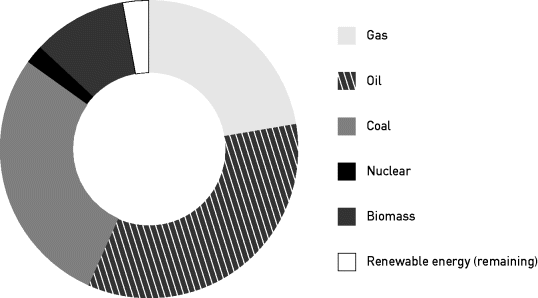
Figure 1.2.3 shows average greenhouse gas emissions due to the use of fossil fuels versus renewable energy technologies. Please note the logarithmic scale on the vertical axis; one can observe that fossil fuels emit approximately 10–100 times more greenhouse gases per kilowatt hour (kWh) produced than renewable energy technologies like biomass, geothermal, hydropower, wind energy, and photovoltaic energy do.
Figure 1.2.3 CO2 emissions due to various energy conversions (Veldhuis and Reinders, 2011)
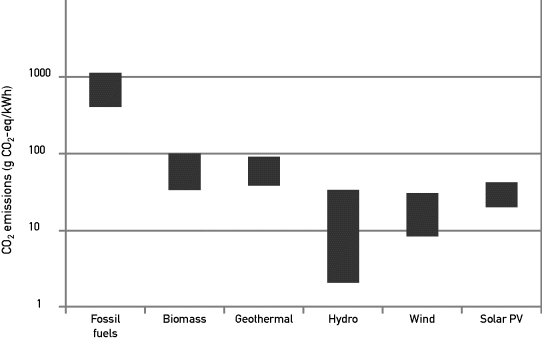
Recently the Intergovernmental Panel on Climate Change (IPCC) concluded that greenhouse gas emissions from the current supply of energy – that is, energy produced by fossil fuels – contribute significantly to the increase of atmospheric greenhouse gas concentrations (IPCC, 2007, 2011). This fact creates a direct link between our energy consumption and global warming due to human activities.
The increase in CO2 concentrations in the atmosphere happens rapidly and can be easily observed by measurements on the ground and by satellites. The higher the concentration of greenhouse gases in the atmosphere, the more global warming. Depending on the scenario, the average temperature of the earth might rise in the next 100 years to perhaps more than 5°C above what is common, with serious consequences for our climate. These changes will lead to more hot days per year and a higher frequency of extremes such as heat waves, heavy rainfall, droughts, tropical storms, and rising sea levels (IPCC, 2007). So far, no single scenario can be identified that will reduce future greenhouse gas concentrations to pre-industrial levels. In any event, we will have to deal with climate change in our common future.
Additionally, other important issues matter, such as our energy security. It is stated (MEZLI, 2011) that, globally, fossil fuels will be sufficiently available for the next 250 years, but the proven reserves of natural gas – at current production – will be sufficient for only 58 years. Also the availability of conventional oil reserves will decrease in the coming decades. Therefore, the price of fossil fuels is expected to remain high and will probably become higher.
To summarize, humankind emits too many greenhouse gases and the depletion of the proven reserves of fossil fuels is in sight. Moreover, significant effects of these developments are expected within this century. As such there is urgency to find sustainable energy solutions, because 100 years is a short period.
To find sustainable energy solutions, two possible paths are available:
- Deployment of new technologies.
- A change of lifestyle.
In various energy scenarios for the future (EPIA, 2011; IEA, 2010; IPCC, 2011; WBGU, 2003; WWF, 2011), it is assumed that 60–80% of greenhouse gas reductions in the course of this century will be drawn from energy supply and use, and industrial processes. These scenarios state that (1) renewable energy and (2) saving energy will play important roles in reducing and sustaining our energy consumption (Figure 1.2.4).
Figure 1.2.4 Pathways to energy solutions
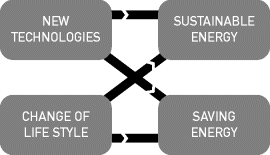
One can think of solar energy conversions, wind energy, sustainable lighting, smart energy management, conversion of kinetic and thermal energy, new forms of energy storage, and hydrogen technology. And, indeed, in practice renewable energy is a growing market (Figure 1.2.5). In the period from 2005 to 2010, the growth rate of biofuels was around 15% and that of wind power was 25%, and various forms of solar energy conversions showed enormous growth rates between 65% and 80% (REN21, 2011).
Figure 1.2.5 Global growth of renewable energy from 2005 to 2010; data from REN21 (2011)
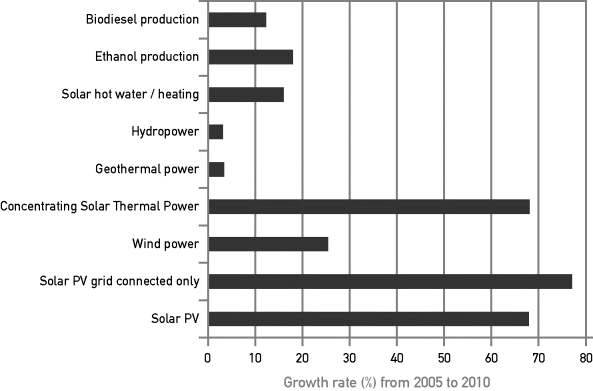
As an example, we will shortly look at the Netherlands. The Dutch government has set targets for greenhouse gas mitigation for the short term aiming at 20% less CO2 emissions in 2020 (compared to 1990). In the same year, 14% of the energy must be produced by renewable sources. Also the Dutch government is striving toward 20% energy savings in 2020, but this goal is not binding.
According to the Netherlands' Central Office of Statistics (CBS, 2011), industry is the largest consumer of primary energy in the Netherlands, with shares of 19% for transportation, 17% for households, and 16% for utility buildings. If this information is presented cross-sector wise, the following numbers can be derived:
- 35–40% of our energy is consumed in buildings.
- 17–19% of electricity consumption is consumed by lighting.
Adding the aforementioned 19% energy consumption due to transportation, we may conclude that at least 70% of the energy is consumed in the context of living, working, and transport. This finding applies generally to many countries, and this context is relevant for the application of sustainable energy in human livelihoods.
